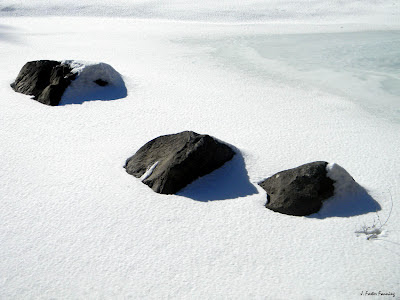An old cottonwood along the banks of the Kettle River reaches up into the cold, early March sky. Not much thawing of the ice flows today. Snow lay deep along the trail. Listening close I could hear the whisperings of ice and water as the river enters the transition from the cold season to one slightly warmer. For a moment the thick clouds parted and rays of sunshine found a distant mountain. It soon passed. The message was clear – not today, not today…
Trekking around in big horn country again today. What a difference one day and a bit of warm sunshine make. Temperatures near 50* give a feel that this winter may be relinquishing it’s near four month grip on the Kettle River Valley.
Here are some images (remember to double click to see the photographs in larger format)…
Mary’s Dome, a prominent feature in the upper Kettle River valley, on the SW flank of Vulcan mountain.
As the ice recedes the lichen grows. Such is the way on these vertical south faces along the banks of the Kettle River . Later in the year temperatures will be so hot that the lichen will all but vanish, drying and shriveling to naught as there will be no moisture to be found during the hot.
Below the ice and lichens, on a very wet, south facing rock wall, the mosses grow thickly. Look closely and you can see several trickles of water dripping through the dense, wet moss. The sound of small, cascading waters were prevalent along this cliff line.
The Oregon Grape are in full ‘red’ as winter’s grip leaves the steep and rocky south slopes of Little Vulcan Mountain. The white snow, red leaves and speckled rock made for a strong composition of the natural elements.
Lichened rocks, red leaves, distant cliffs, towering Ponderosa Pines and a shear rock wall, what’s not to like on a sunny afternoon trekking about in the mountains? Given this was the warmest day of this winter, the ice falls that had frozen onto the vertical rock faces were melting and breaking loose, often tumbling 100+ feet from the rock above. Hundreds of pounds of ice crashing down and shattering thousands of small pieces on the rocks below. Made for an interesting hike.Pinja pup on a boulder that several years ago came to an abrupt stop against this young tree (which still bears the scars).
An image of a cottonwood starkly silhouetted in the winter’s afternoon sunshine…
These three rocks, still frozen into the Pinja on guard…
It was a strenuous day, hiking about in the mountains. Walking was a combination of post-holing thru snow, skiing on loose rocks, sliding on hard crusted ice and slipping in muck. But the warm sunshine made up for it all…
To close a fine afternoon we had this pileated woodpecker visit as we were walking back to the rig….
Thanks for checking in...


































